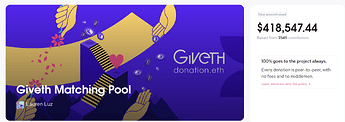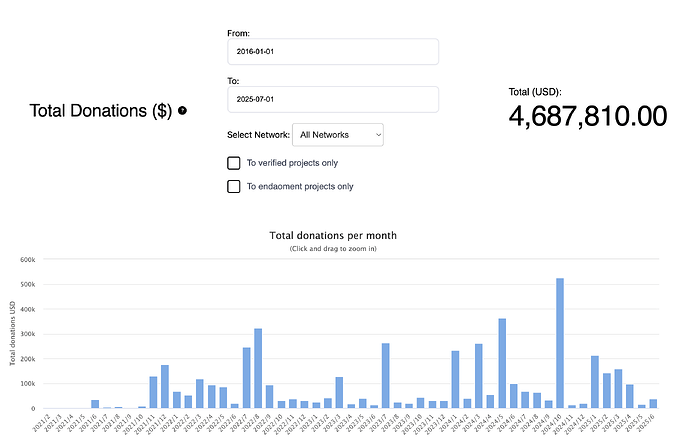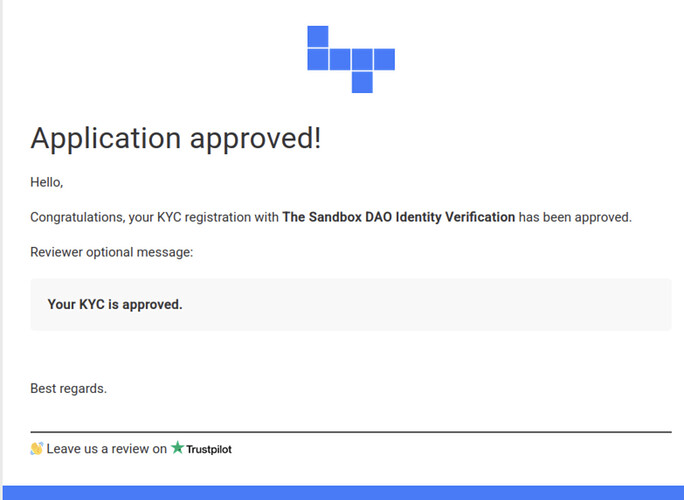Q1 Name of your Grant
Enter the name you want your Grant to be known as.
SandboxDAO × Giveth - Quadratic Funding Round for Supporting Community-Led Public Goods
Q2 Total Grant amount in USD ($)
Enter your grant request in USD ($). Anything over 3K USD is allowed and will face higher scrutiny per Project Diversity metric of SIP-25.
Answer:
$26,750 – $53,500 USD
Fee structure:
- Solo Round - For a $53,500 grant, $13,500 is used for operations; $40,000 powers the matching pool.
- Main sponsor - For a $26,750 grant, $6,750 covers operations; $20,000 goes directly into the matching pool.
![]() We are also open to smaller contributions (e.g. $10K–$20K total), with proportional fee and exposure adjustments. These funds would be pooled with other sponsors in a shared round.
We are also open to smaller contributions (e.g. $10K–$20K total), with proportional fee and exposure adjustments. These funds would be pooled with other sponsors in a shared round.
Q3 Evaluation Factor – Specific
Include specific outcomes (end result) for this grant.
Lanzer will be answering:
- Is it obvious what this grant wants to achieve?
- Is this grant explained in a way that doesn’t require additional context outside of this grant application?
Answer:
We are proposing a Quadratic Funding (QF) round on Giveth that is either co-sponsored or fully sponsored by Sandbox DAO. The QF round will amplify community engagement and charitable giving while highlighting Sandbox DAO’s leadership in decentralized ecosystem empowerment.
Specific Outcomes:
• A matching pool seeded by Sandbox DAO and distributed using QF logic to support high-impact, community-nominated public goods projects.
• Increased visibility and alignment between Sandbox DAO and the public goods ecosystem, with branding and participation throughout the round.
• Strong engagement through co-marketing, donor participation, and measurable ecosystem growth.
The result is a transparent, community-led grant allocation process, with all funds going directly to supported projects.
Q4 Evaluation Factor – Measurable
Include 3 measurable milestones that track progress toward the grant outcomes. with recommended payment %s that total to 100%.
Lanzer will be answering:
- Does this grant have at LEAST 3 milestones? (There is no penalty for only 3)
- Do these milestones make sense?
- Are the grant outcomes distributed evenly across these milestones?
- Do the recommended payment %s per milestone all total to 100%?
Answer:
Milestone 1: Round Launch Preparation (~25%)
- Confirm sponsorship level (solo/co-sponsor), and round specs
- Define matching pool network, eligibility criteria, and timeline.
- Begin co-marketing coordination
- Giveth charges of grant upfront for round operations, platform setup, and coordination
- Note: Giveth receives an operations fee for platform management, dev works, sybil resistance, analytics, marekting, and round coordination.
- For $53,500 total: $13,500 goes to Giveth (~25%) and $40,000 is used for the matching pool.
- For co sponsorship (e.g. $26,750): Giveth receives $6,750 (~25%), with $20,000 for the matching pool.
Milestone 2: QF Round Execution (0%)
- Opening of projects application process, curation, verification, onboarding of projects
- Launch QF round on Giveth platform (with round page, matching logic, and verified projects)
- Feature Sandbox DAO in landing page, announcements, threads, blogposts, host Twitter spaces featuring Sandbox DAO members and projects participating in the round
- Roll out social campaign, and provide live round support.
Milestone 3: Post-Round Wrap-Up (~75%)
- Conduct sybil analysis (using COCM mechanism, on-chain tools like Arkham, Zapper, etc)
- Conduct matching calculations and publish round results
- Publish final donation and matching results, analytics, forum post and Snapshot ratification vote
- Distribute matching funds
- Conduct recap blog post and social media announcements
- Share feedback survey and incorporate insights
Total: 100%
Q5 Evaluation Factor – Accountable
Provide a primary and secondary PUBLIC point of contact for this grant. There is no need for email.
Lanzer will be answering:
- Was a primary and secondary contact listed?
- Can one or both of these contacts be reasonably thought of as owning the success or failure of the grant?
Answer:
Primary Contact:
Yegor Golovnia → https://x.com/yegorgolovnia
Role: Program Manager for the QF round, responsible for full execution, including planning, project onboarding, platform coordination, donor comms, post-round reporting, and fund distribution.
Secondary Contact:
Jake → https://x.com/GivJake
Role: Supporter and fundraising steward. Jake will support with fundraising coordination and act as a secondary point of contact for Sandbox DAO and ecosystem partners.
Q6 Evaluation Factor – Realistic
Define the realistic impact of your grant outcomes on the Sandbox ecosystem.
Lanzer will be answering:
- Do these impacts make sense for the Sandbox ecosystem?
- Do any of these impacts connect with the people, product, or purpose of the Sandbox (timestamp 29:54 to 31:00) OR does the grant author clearly explain how it reasonably connects to the Sandbox ecosystem in a way not covered by the linked video? (Impacts not covered will receive increased scrutiny during evaluation)
Answer:
The round directly supports community engagement and charitable giving, one of Sandbox DAO’s stated funding priorities. Giveth QF rounds match small individual donations with pooled matching funds to amplify support for grassroots and public goods projects . This is a low-lift, high-impact mechanism for Sandbox DAO to fund projects that align with Web3 culture, decentralization, education, social impact, and regeneration, all while giving visibility to the SAND token and DAO initiatives.
Giveth has proven this model through 12 previous rounds, supporting 4,000+ projects and attracting over 22,000 donors.
Q7 Evaluation Factor – Timely
Describe the timeline for completion of the grant outcomes.
Lanzer will be answering:
- Do the grant outcomes fully complete before the SGDP program end of August 30th?
- Is the timeline clearly laid out and easy to connect with the measurable milestones?
Answer:
The round can be delivered within a ~6 week window post-approval.
Timeline example:
- Week 1: Confirm sponsorship and finalize scope
- Week 2–3: Marketing campaigns for the round launch, preparation and application window, curation and projects onboarding
- Week 4–5: Run the QF round (typically 14 days)
- Week 6: Reporting, analytics, fund distribution, co-marketing wrap-up
The entire project can be completed before August 30, 2025.
Q8 Evaluation Factor – Disclosure
Fully disclose those who benefit from your grant. Include a link to read about them, how they benefit, and the group/business/entity they are associated with or belong to.
Lanzer will be answering:
- Are the disclosed persons findable on X, LinkedIn, or other websites where Lanzer can read about them?
- Is it clear what group/business/entity these disclosed names associate with or belong to?
- Is it clear how the disclosed persons/groups will benefit (monetarily, DAO voting power, etc)?
Answer:
Beneficiaries
1. Giveth Core Team
- Organization: Giveth
- Website: https://giveth.io
- Key Public Leads:
- Griff Green →https://x.com/thegrifft (Founder)
- Lauren → https://x.com/karmaticacid (Mission Specialist)
- Jake → https://x.com/GivJake (Fundraising & Biz Dev Steward)
2. Yegor Golovnia
- Role: Program Manager, Giveth QF, https://x.com/yegorgolovnia
- Responsible for full round coordination, project onboarding, timeline delivery, and reporting.
How They Benefit
- Giveth receives a designated operations fee to cover platform setup, dev resources, sybil protection, community support, comms.
- For a $53,500 solo sponsorship, $13,500 (~25%) goes to Giveth, and $40,000 is used for the matching pool.
- For a $26,750 co-sponsorship, $6,750 (~25%) covers ops, and $20,000 goes to the matching pool.
- For rounds over $100K, Giveth charges 15% of the matching pool instead of a flat fee.
- The remaining 75–85% of the grant is distributed directly to community-nominated and donor-selected public goods projects through transparent Quadratic Funding.
Future Beneficiaries (To Be Determined)
- Project recipients are not yet known. They will be selected, verified and onboarded in the lead-up to the round and selected by round sponsors and Giveth based on the defined eligibility criteria.
- All projects will be publicly listed and their impact traceable via the Giveth projects explorer and QF round page.
- Full transparency will be maintained - all transactions, results, and fund distributions are fully onchain.
How did you hear about the Sandbox DAO Grants Program?
Referred by a Giveth team member during research into aligned public goods ecosystems and initiatives.






